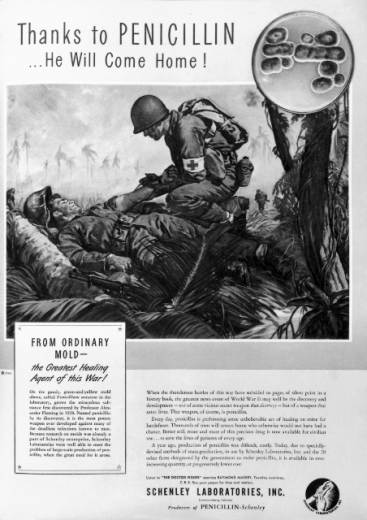Inside this little bottle is a substance which marked a huge turning point in medical history: Penicillin. The first antibiotic to be discovered and mass-produced, it appeared to be a wonder drug which enabled doctors to effectively treat infection for the first time in history.
Credit: Science Museum/SSPL
In 1928, Dr Alexander Fleming returned from holiday to find a mould growing in one of the Petri dishes in his lab. Upon closer inspection under a microscope, he discovered the mould was preventing the growth of bacteria in the dish, and he came to a remarkable conclusion: the Penicillium mould could potentially be used to fight infection.
It was 10 years later that Fleming’s discovery was picked up and worked on by a team at Oxford University. The team, in collaboration with American scientists, developed Fleming’s discovery into an effective drug which could be mass produced. This crucial breakthrough came during World War II, when vast quantities of the lifesaving antibiotic were desperately needed for treating a range of war-related infections.
The substance in our bottle is some of the first penicillin to have been manufactured, clinically tested and used by the military. In an effort to begin mass producing the drug, a solution was made by a chemical company and then sent on a truck to a team in Oxford University. Their job was to take the weak solution, extract the valuable penicillin from it and purify it. The browny-yellow colour is due to remaining impurities in the sample.

Credit: Science Museum/SSPL
However, as Fleming correctly predicted in his Nobel Prize Lecture, the misuse of Penicillin would cause harmful microbes to become resistant to the antibiotic.
Today, antibiotic resistance poses a serious threat to progress, as people are dying from bacterial infections which used to be treatable. It is thought 25 million courses of antibiotics are incorrectly prescribed every year in the UK for ailments such as coughs and colds that don’t require the use of this valuable treatment. To combat this growing issue, the Longitude Prize set a challenge to design a test that will help healthcare professionals administer antibiotics correctly, with a £10 million prize for the winning idea.
Do you think the development of Penicillin was the most important medical breakthrough in history, or are there other more important advances?
Laura Body is a member of the Learning Support Team.
To see this object and discover more about the story of penicillin, visit the Churchill’s Scientists exhibition, open until March 2016.